
Author: Amy Ren
Williston Northampton School
April 26, 2020
I. Introduction
According to World Health Organization or WHO’s description, Coronavirus is “a large family of viruses which may cause illness in animals or humans” (Source 21). As is well-known now, the whole world has been impacted by this novel virus, COVID-19, that started in Wuhan, China in December, 2019. This has spread fear understandably but it also has had a real impact on people’s lives both socially and economically and has endangered public health. In particular, low income workers have been affected adversely and the purpose of this paper is to describe and analyze the impact on such workers in China.
In Asia, such as Korea, the first firmed case was a 35 years old woman came from Wuhan in January 20th. In the same week, three more cases occurred as travelers from Wuhan tested positive in the airport. There was the first confirmed local case in Korea in January 30, a man who ate a meal with the confirmed case 3. On February 18, a 61 years old woman tested positive for COVID-19 at Shincheonji Church of Jesus in Daegu. Within the next few days, 15 more people were confired with covid-19, and one month later, thousands of people who had the connections to the church were confirmed as well. In March 25th, the Shincheonji Church accounted for 5,080 confirmed cases. Until April 17th, there’re 10,635 cases confirmed (Source 1). On April 16, Prime minister Shinzo Abe in Japan declared nationwide state of emergency due to the worsening situation in the country (Source 6), and it will remain in force until May 6. In addition, the Olympic Games Tokyo 2020 was postponed to July 23, 2021, due to the outbreak of COVID-19 (Source 7).
In Southeast Asia, Thailand had the first confirmed case outside of China in January 13th, but the case remained under 100 for nearly two months. However, cases increased from 82 on March 14th to 721 on March 23, and the majority of those cases were community spreading. In Malaysia, because of large religious gathering and the unrestricted , the case increased increased from 29 on March 1st to more than 1500 on March 23 (Source 2).
Outside of Asia, in Europe, the first case is reported on January 24th. In an online briefing on April 16, the WHO’s regional director Hans Kuge said, “Case numbers across the region continue to climb. In the past 10 days, the number of cases reported in Europe has nearly doubled to close to 1 million”, which means 50% of the global burden of COVID-19 was in Europe. Until April 16, according to ECDC (European Centre for Disease Prevention and Control), there are 925,536 cases in total. More importantly, WHO said that the coming week of April will be very critical for Europe. Comparing with other countries’ data of COVID-19 in Europe, Spain, Italy and Germany had more significant amount of confirmed cases (Source 4). The first two confirmed cases in Italy was on January 31, until April 16th, there are 165,155 cases in total reported in the country. At the same time, Spain also had its first reported case on January 31, and until April 16, there’re 177,633 confirmed cases. The first confirmed case in Germany was on January 28, until April 16, there’re 130,450 confirmed cases in total. Also, the foreign secretary Dominic Raab in Britain announced there will be at least three more weeks of lockdown due to the pandemic (Source 8).
The Latin America country has been most affected is Brazil. The country has its first confirmed case on February 26. Until April 16, there’re 28,912 cases confirmed. Peru has its first confirmed case on March 6, a 25 years old man who traveled back from France, Spain and Czech Republic.
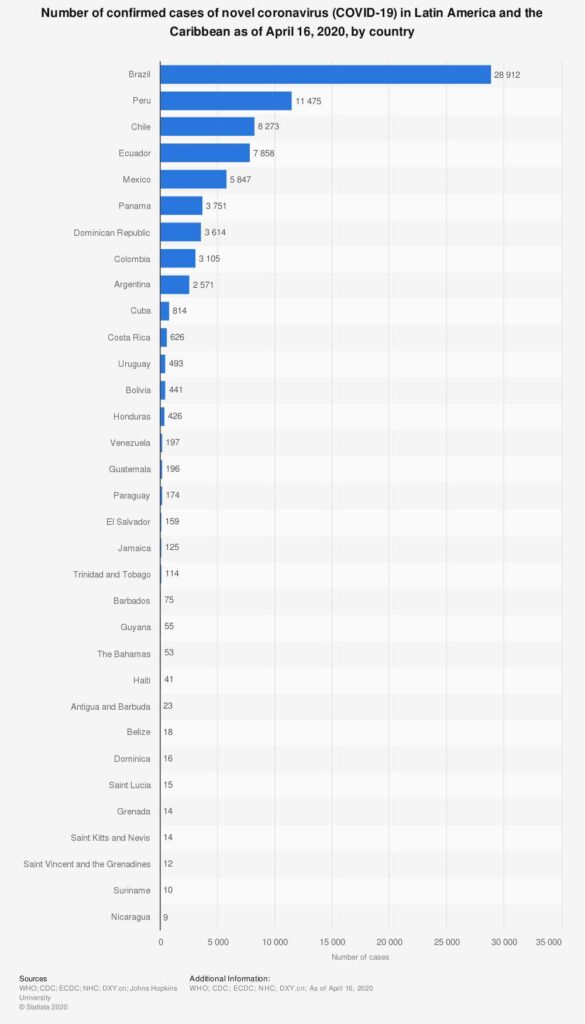
Section 2 begins with a brief chronology of COVID-19 outbreak in China. It summarizes how did CVC start and spread in China, and the government’s measures taken to halt the virus. In addition, it compares the current virus situation with that due to SARS in 2003. Section 3 describes COVID-19’s impact on the global economies as well as the local economy in China. Using data and graphs it describes the effects of COVID-19 around the world but especially in China. Section 4 describes the specific type of workers this paper will focus on i. e. the low income workers in China. Section 5 discusses how COVID-19 impacts low-income workers in China, and compares it with SARS’s case of 2003. Section 6 presents the Chinese government’s measures to help the local economy and especially the low-income workers. The paper also analyzes measures taken by other countries’s to point out possible future policies for improving the needs of low-income workers after the COVID-19 crisis.
II. Spread and containment of COVID-19 in China
COVID-19 is the infectious disease that is caused by the recently discovered Coronavirus, and the accompanying symptoms are fever, dry coughing, runny nose, or diarrhea. The virus can spread from person to person through small droplets from the nose and the mouth when a person who carries COVID-19 coughs or speaks. Once the virus is in the body, it takes hold first in the upper respiratory tract, so the patients begin to experience fever, dry cough or shortness of breath (Source 22). The symptoms become more and more severe once the virus moves to the lower respiratory tract where it may cause severe problems like bronchitis and pneumonia. It happened in Wuhan, China, first in December before the outbreak, but until March 13, 2020, there are 142539 cases happened in the world and 5393 death in total. On March 11, WHO declared Coronavirus as a pandemic. In the following days, Italy, America and Spain announced national states of emergency in their efforts to deal with this pandemic. China reported to WHO a few numbers of pneumonia cases on January 4, starting from January 23, cities in China like Wuhan, and other provinces like Hunan, Guangdong and Zhejiang started to lock down the cities and impose travel restrictions. Most people paid no attention in the beginning as the CVC occurred, however, as the infection numbers exponentially increased in the country, government immediately posted policy – requiring people to stay homes and the schools started online classes.
Comparing with SARS, or Severe Acute Respiratory Syndrome, that happened in 2003, the case of COVID-19 is much more serious and devastating. The first identified case was in Foshan, Guangdong, China, and it is primarily transmitted through person to person. According to WHO, the epidemic of SARS affected 26 countries and resulted in more than 8000 cases in the world. But, until April 12, 2020, 09:25 GMT, there are already 1,787,069 people infected to COVID-19, which is almost 223 times greater than SARS (Source 24).
III. Impact on the global as well as local economy in China
In China, according to the China National Bureau of Statistics, industrial production, sales and investment all fell in the first few months of the year compared with the same time period in 2019. Industrial output fell 13.5% in January and February of 2020, retail sales dropped to 20.5%, and fixed asset investment fell 24.5%. According to the latest first season China GDP from the National Bureau of Statistics, the Primary Industries and Resources fell by 3.2%, and it includes crop planting, forestry, animal husbandry, aquaculture and other direct production of natural products as the object of production. The Second Industries and Resources fell by 9.6%, and the Third Industries and Resources fell by 5.2%. In total, the first season of China’s GDP fell by 6.8% (Source 11). This is the first time that China’s GDP shrinks for the first quarter of the year, and it mainly because of the COVID-19 crisis. Looking closely at the chart below, comparing with the previous years, agriculture, industry and service industry all grown by negative percent. Comparing with the Second and the Third
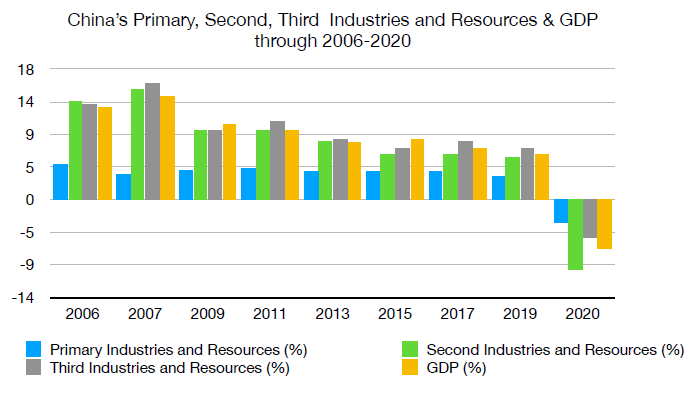
Industries, COVID-19 had the least impact on the Primary Industries. However, agriculture and animal husbandry was still effected by different provinces’ travel restriction and African swine fever, which makes it hard for farmers and vendors to sell and circulate their products. In Fenghuang News, an interview of a vegetable vendor from a small town near Wuhan exemplify some dilemmas that people at Primary Industries faced. On January 23, one day before he’s going to sell those vegetables to the city, the Wuhan government announced level I major public health emergency – closing the exit channels of all provincial, county and township or even some village roads, and forbidding the passing of all vehicles and personnel. It is very hard for him to go to the field to pick his vegetables, not to even speak of selling those. This is absolutely a huge loss for those farmers, but at least the local government gave some measures to help on maintaining their basic living and small amount of selling. Although the first season of Primary Industries have a negative growth percent, most of people at this industry slowly returned to work in March. According to the press spokesman Shengyong Mao from National Bureau Statistics on April 17, inside of this -3.2%, agriculture (farming) is still on its stablest level, and it has a year-on-year growth of 3.5%. Because climatic conditions in the main agricultural areas are generally favorable, which is beneficial for the spring sowing. In the end of March, the first and second type of winter wheat’s area sown was 87.2%, which is 3.5% higher than 2019. The output of poultry eggs increased by 4.3% and milk increased by 4.6%, except the total value of output of animal husbandry was fell by 10.6%. Because the animal husbandry holds nearly 45% of the total Primary Industries, which kind of slows down the growth rate.
The Second Industries and Resources fell by -9.6%, and this is a result of declining in domestic and foreign demands brought by COVID-19.
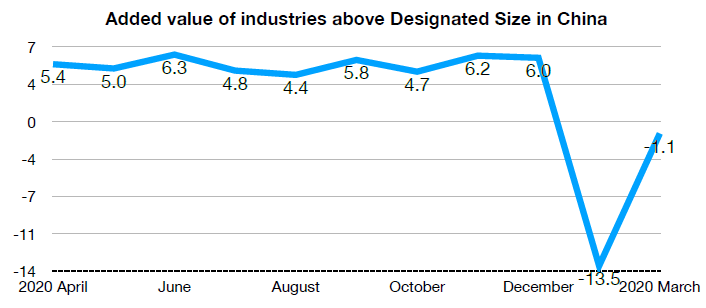
Most of the industrious production in China stopped from January to February, but along with the returning to work on March, industrial output in March narrowed to -1.1% from – 13.5% in the previous two months (Source 12). But, because of the spread of COVID-19 all over the world, some orders were canceled instead of increasing. The Third Industries was fell by -5.2%, catering
industry drops 44.3%, retail industry drops 19%, but the information industry increases 13.2%. In early January to February, the Third Industries drops 12.2%, but in March it narrowed by 3.9 percent point. Because most of the activities became online, new economies such as fresh delivery, online education, telecommuting and online health care are growing quickly. From January to February, China’s mobile Internet access traffic reached 23.5 billion GB, up 44.2% year on year. Revenue from online game services above a certain size grew by 7.7% year on year, Internet platforms by 9.5%, Internet search services by 10.3% and Internet data services by 21.4%.
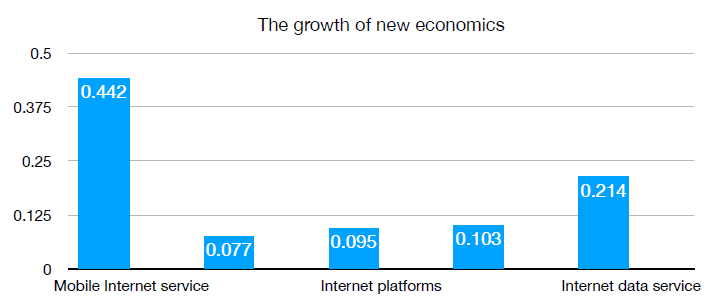
Meituan is one of the biggest food service companies in China, according to its report on March, most of local living services (catering, entertainment, education, etc.) open in late march or later. At the same time, all kinds of merchants generally face the difficulty of no customers. As many as 71.7% of residents chose to order food delivery at Meituan during the outbreak of COVID-19. Online orders exceeded offline consumption (53.7%), and 41.6% of residents chose to buy daily necessities through Meituan or Meituan Paotui. In their data, delivery accounted for 53.6% of the merchants’ revenue, up to 42.9% of the merchants took delivery more than 70 %. Moreover, because of COVID-19, some middle- aged and elderly people who have not been exposed to online consumption are also trying online services (Source 14).
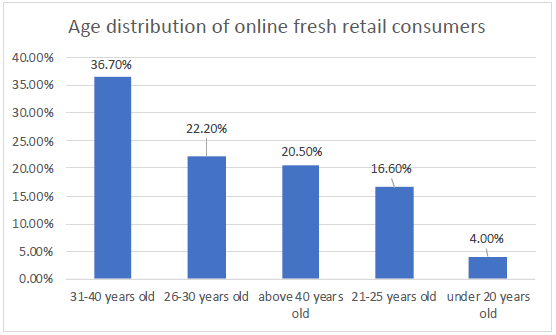
According to the press spokesman Shengyong Mao from China National Bureau of Statistics, the surveyed urban unemployment rate fell in the first quarter of this year, but the overall employment situation remained stable. In the first quarter, 2.29 million new urban jobs were created, and the surveyed urban unemployment rate was 5.9% in March, down 0.3 percentage points from February. In addition, the total labor force for migrant workers is 122.51 million people.
Comparing SARS and COVID-19, this two crisis have different impact on world’s economy. For SARS, almost 8000 lives died from this virus, which shaved 0.5% to 1% off China’s growth in 2003. In addition, China accounted for 4.2% of the global economy in 2003, while it controls 16.3% of the world’s GDP in 2020. It means the slowdown of Chinese economy because of coronavirus will certainly impact the world’s economy now. All provinces in China extended the lunar new year holiday by 10 days to contain the spread of COVID-19 (Source 26).
Quarantine and travel restrictions create both short-term and long-term economic consequences on the globe by disrupting normal activities, production and trade. World Trade is expected tofall between 13% to 32% in 2020 since the COVDIS-19 disrupted most of the economic activities. It is certain that every country faces dilemma because of COVID-19, but some developing countries are in a worse economic situation in particular. Nearly 100 countries closed boarders, and DESA predicts that it may leads to a global economic contraction of 0.9 percent by the end of 2020 or even higher. Lockdowns in Europe and North America hit service industries that involves in physical interactions hard, but those industries account for almost a quarter of jobs for economies. ETUC (European Trade Union Confederation) reported that unemployment rate has risen by at least 4 million since the crisis begin, for example, France has the highest known number of workers on short-time work at 3.9 million. Developing countries that depended on tourism and commodity exports are also hit hard by the travel restrictions and quarantine policy (Source 25). The graph below show that the stock market is on a downturn while facing the outbreak of the coronavirus.
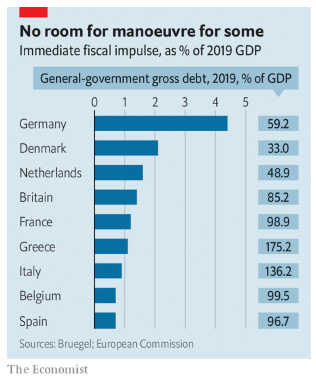
First, it began in the oil market made its way through the global financial system, then it added concerns on a large amount of the investors about the state of the economy (Source 28). They fell more than half in March, but the oil price provides 90% of Iraq’s state revenue. However, the gold price is relatively stable compare with the oil price. It is considered as a safe heaven” for most of the investors, but the price still tumbled briefly in March.
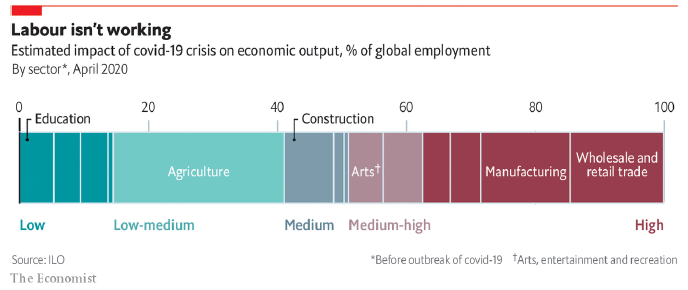
Right after President Donald Trump announced that the US economy maybe facing recession, the Dow Jones Index closed 12.9% down (Source 23). Until March 23, 2020, the US stock market triggers a market wide circuit breaker four times. The travel industry has been badly damaged, with airlines cutting flights and tourists canceling business as well as vacation trips. Governments around the world have introduced travel restrictions to try to contain the virus. The EU banned travelers from outside the bloc for 30 days in an unprecedented move to seal its borders because of the Coronavirus crisis. In the US, the Trump administration has banned travelers from European airports from entering the US. Data from the flight tracking service Flight Radar 24 shows that the number of flights globally has taken a huge hit. The Bureau of Statistics announced that the numbers of unemployed persons who were jobless increased by 1.5 million in less than 5 weeks to 3.5 million. In addition, the Labor Apartment reported on April 23th that 4.4 million Americans filed for unemployment insurance in the week ending with April 18th, bringing the five weeks in total to 26.5 million (Reference 37).
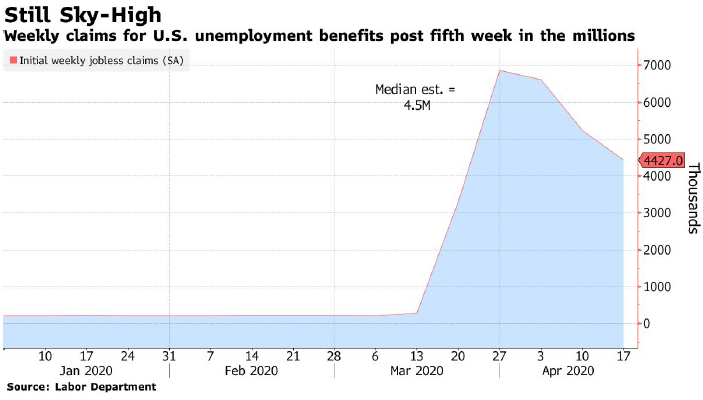
According to OECD, the world’s economy could grow in its slowest rate since 2009 because of the coronavirus outbreak. Now, as data suggested, Chinese businesses that survived the outbreak are back at work. According to the cnbc website, official and third-party figures say the resumption of work rate is generally 70% or even higher”.
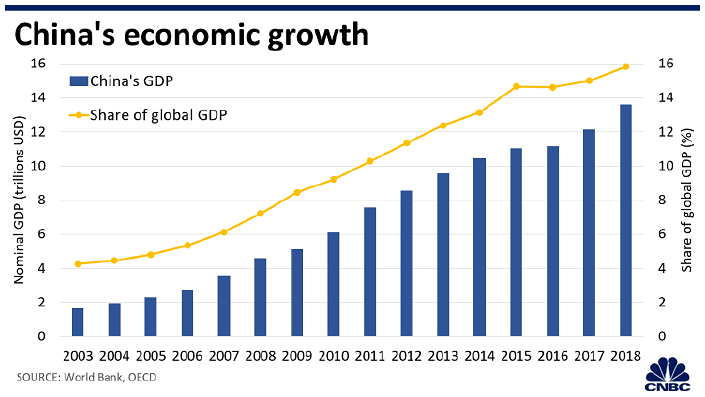
The International Monetary Fund predicts that the global economy will contract by 3% in 2020. Migrant workers are one of the most vulnerable groups since they tend to work in sectors and have less protections under this circumstance. In India, the government has welfare measure to people below poverty line, but migrant workers rarely have access to it. Jan Sahas, a nonprofit, conducted a survey about the impact of COVID-19 on migrant workers. The survey showed that 62% of workers did not have any emergency welfare measure and 37% did not know how to how to access the existing schemes (Reference 38). Also, in Singapore, there’s almost a quarter of the city’s 5.7 million residents are migrant workers, and the average migrant workers earn $400-465 a month, according to TWC2 (Transient Workers Count Too).
IV. Who are Low Income workers in China
According to the policy, poverty line in China are people who earn 3535 CNY per year or less. Low income group refers to people whose income is lower than the annual income or monthly income stipulated by the state or the province. Most of low-income people are the unemployed, destitude families and the disabled people. In China, each province sets its own minimum wage according to its local economic situation. For example, in Beijing, the monthly minimum wage is 2200 CNY, while in Loud, Hunan, the monthly minimum wage is 1,130 CNY (Source 39). China’s labor force rate dropped to 68% compared to 68.5% in 2018. Unemployment rate increased to 3.6% in Dec, 2019. According to Chunyan Wang, the deputy director general of the poverty relief office under the state council: A total of 20.8594 million migrant workers in 25 provinces have left home for work, accounting for 76.43 % of the total number of migrant workers last year. It’s an increase of 6.659 million and a 24.4 percentage points since March 6 (Source 15).
Most of low-income people in people received limited education or none, and they are often migrant but not always. For example, low-income families that receive the minimum living guarantee from the government are disabled people (old or young) who cannot work, some left- behind children’s families, and etc.
IV. How are low-income people impacted because of COVID-19
Wuhan was placed under lock-down since January 23, and people except doctors, nursers or workers for food delivery and supermarket can continue to work. Most of white-collar people can do their jobs remotely, while food delivery workers and some small shops owners cannot stop working because they lack of saving. In addition, months of restrictions on travel, work and daily life are putting huge pressure on low-income families at the margins of society. According to a survey of 120,000 people conducted last week by the China Household Finance Survey and Research Centre, a respected independent consultancy in Chengdu, “A fifth of Chinese households can survive only 2.3 months without any income, while 40 per cent cannot last past three months” .
Chunyan Wang from Poverty relief office of the state council said that the decrease in consumer demand and the travel restriction because of COVID-19 has indeed affected the sales of agricultural and sideline products, and there are some places appear unsalable, such as Hainan’s winter melons and vegetables, Yunnan’s flowers and so on. Most of low-income families are lack of social support, and they cannot get payed regularly because of the travel restrictions. Most of them face the poverty line, and have to pay other expenses as well. Some of migrant workers inside of this group have bigger dilemma since they cannot go back to home or the working place, and they are separated with their families. This situation made it hard for ow-income people to keep cash coming in, or even sustaining their basic living. One type of them are people who are infected to covid-19. The health code for many patients are still red, meaning that many low-income patients, even if they recover, cannot work outside the home. Affected by physical damage, health code, employment discrimination, which means new patients will be absent from work for a longer time than ordinary people, or bring new illness to the poverty line again. In addition, many migrant workers do not have unemployment insurance. Moreover, the reporter from xueqiu.com said that the outbreak has worsened the plight of some already poor families, depriving them of their last source of income, such as informal workers such as waste- pickers and small traders. Some households ran out of savings and began to borrow the money from different means. In addition, most of these families suffer from poverty caused by illness, loss of the main labor force, single parent, inter-generational support and other situations (Source 35).
Although most of factories try to return to business as soon as possible, as of late February, only 30% of China’s small and medium-size companies had returned to normal operations, according to a survey by the Ministry of Industry and Information Technology. According to Wall Street Journal, in a survey of more than 8,000 working professionals by Chinese recruitment website Zhaopin in mid-February, one-third of respondents said they had observed companies cutting jobs, and 46% said they knew of firms that hadn’t paid salaries on time.
VI. China’s measurements on helping low-income groups during COVID-19 period
According to the data from National bureau of statistics, from January to February, retail sales of consumer goods fell by 20.5 per cent year-on-year. Among them, merchandise retail sales fell 17.6 percent, and food and beverage revenue fell 43.1 percent year on year. In the face of considerable decline, it is necessary for governments at all levels to take active measures to boost consumer confidence and promote economic recovery. For helping most of families, and particularly low-income groups, lots of cities announced the issuance of consumption vouchers to the public to encourage and guide residents’ consumption and relieve the pressure on some enterprises and industries caused by the COVID -19 outbreak. According to incomplete statistics, more than 30 cities in China have issued consumption vouchers, which sums up to more than 5.6 billion yuan. Among them, Nanjing, Hefei, Hangzhou and other places chose to issue consumption vouchers through alipay, with an amount of more than 4 billion yuan. As of April 7, more than 10 million offline businesses across the country had benefited from the vouchers, more than 90 percent of which are small, medium and micro businesses. Also, the central government has allocated 139.6 billion yuan for poverty alleviation, and construction has begun on more than 260,000 poverty alleviation projects in 22 provinces in the central and western regions. According to Shengyong Mao, “In terms of income, the per capita disposable income of some provinces with a large number of low-income people, such as Sichuan, Guangxi, Tibet, Guizhou and Qinghai, rose by 5.3%, 4.6%, 9.5%, 4.8% and 3.1% in the first quarter in nominal terms, respectively, significantly higher than the national level”.

From January till now, Alibaba announced a program called “Tianmao Zhunong” (天猫助农/爱⼼助农). It aims at helping some low-income farmers to sell their unsalable products such as Jiangsu’s local eggs, Dandong’s strawberries, etc. Thirty leading Chinese agricultural industry experts have teamed up with Alibaba’s “love to help farmers” program to help farmers who are facing dilemma because of COVID-19. More importantly, China has a strong online selling system, which also greatly helps those low- income farmers too. According to Xinhua net, Ten thousand farmers start to sell vegetables through live video at Taobao, and more than 300 anchors participated into these lives to help those farmers. Ali’s program helped farmers sell more than 30,000 tons of agricultural products. Jingdong reached 10,000 tons of unmarketable agricultural products cooperation with 14 regions; Pinduoduo’s “live broadcast room for mayors and county heads” won 170,000 orders and sold more than 1 million kilo of agricultural products (Source 18).
(Picture 1: One county leader and an anchor started to sell their local specialty at Taobao. Picture 2: three different famers also tried to sell their own fruits through live videos at Taobao)

The chairman Jingpi Xi said on March 6 that the governments should support the low-income labor workers employment in priority, and they should prefer to use and organize them in face of some opening of major projects or constructions. The governments should encourage enterprises to employ more people from low-income areas, and giving “ID card” for those low-income people. In addition, there is always a petty loan program for low- income farmers in China (Source 19). On January 31, sichuan province issued a document to give proper preference to the credit policy, flexible adjustment of repayment arrangement and reasonable extension of repayment period for the poor people who have temporarily lost their income source due to the epidemic. Those who raise objections or complaints against bad credit records due to epidemic prevention and control should be timely verified and properly handled. Taking Guizhou province as an example, during the COVID-19 period, a total of 19,400 households extended small-amount credit loans for poverty alleviation with a total amount of 943 million yuan, and 27,200 households with a total amount of 1.138 billion yuan. Also, on April 25th, the Ministry of Civil Affairs in China posted a new policy on helping low-income families who suffered from COVID-19. According to the degree of difficulty, each family will receive temporary aid from 1000 yuan to 10000 yuan (Source 36). So far this year, local governments in China have provided 3.71 billion yuan in temporary aid to help people who live with subsistence allowances and those in extreme poverty. So far it benefited over 81.689 million people. In accordance with the standard of no less than 500 yuan for urban residents and no less than 300 yuan for rural residents, Hubei government provides daily material assistance to both urban and rural low- income residents (Source 20).
VII. What are low-income group’s remaining needs & possible policies
On early April, India announced $22.5 billion stimulus package to “be disbursed through food security measures for poor households and through direct cash transfers.” Also, South Korea announced cash payments of up to $186 per household except for the top 30%. In America, the White House announced A $19bn “food assistance program under the new pandemic”. It provides assistance to affected farmers, and distributors, also ensures the safety and stability of the food supply chain.
There are still some families in need did not receive temporary help from the government on time. And there are still a large numbers of vulnerable people above the government’s poverty line and subsistence allowance, who are not included in the government’s aid system. And even those on subsistence allowances, for some struggling families, cannot cope with the extra impact of this COVID-19. Also, some families who have multiple children cannot even pay for their tuition since they are not receiving free education. If the government cannot give any support to those low-income families in the rural areas, they will have maybe hundreds or thousands tuition fee, which is a lot for them.
- Government should strictly follow the rules of helping every low-income families as much as possible
- Learning from countries like Japan and Korea, giving direct cash grants to low-income groups.
- Giving education about COVID-19 to low-income families, raising their awareness on this global pandemic
- Working harder to alleviate poverty through employment, and ensure that jobs are stable and expanded; supporting leading enterprises and workshops in poverty alleviation to return to work as soon as possible.
VIII. Concluding Remark
The outbreak of COVID-19 influences the world tremendously in terms of health, everyday living and studying. Until April 26th, there’re total 2,939,386 people confirmed with COVID-19, and 203,703 people died from this pandemic. My paper focused on one of the most vulnerable parts of the population – the low-income groups. I summarized the impact of COVID-19 in China and also the globe in the third section, but specifically focused on China. In the next section, I analyzed how the low-income workers in China are affected because of COVID-19, and my major findings are:
- Quarantine and travel restrictions create both short-term and long-term economic consequences on the globe by disrupting normal activities, production and trade.
- China has its uniqueness on advanced delivery and online shopping services, which brings tremendous help to people during the CVC period.
- Most of low-income families are lack of social support, and they cannot get payed regularly because of the travel restrictions. But the Chinese government already gave some measurements to help those families such as providing cash and cash coupon in different cities.
- Taobao Zhunong and other similar programs combine the power from local governments and social influencers bring a lot of benefits and help to farmers or vendors. These program are very special and efficient, and only occurred in China.
References
This paper has benefited from the following references, however, for simplicity, we have not always make explicit mention of these references in the body of the paper. Paper Mentor: Dr. Tayyeb Shabbir, Wharton School
- How a South Korean church helped fuel the spread of the coronavirus. (2020, March 25). Retrieved from https://www.washingtonpost.com/graphics/2020/world/ coronavirus-south-korea-church/
- COVID-19 in Southeast Asia: outbreak delayed but developing • Stimson Center. (2020, April 24). Retrieved from https://www.stimson.org/2020/covid-19-in-southeast- asia-outbreak-delayed-but-developing/
- Situation update worldwide, as of 28 April 2020. (2020, April 28). Retrieved from https://www.ecdc.europa.eu/en/geographical-distribution-2019-ncov-cases
- Statement – Transition to a ‘new normal’ during the COVID-19 pandemic must be guided by public health principles. (2020, May 1). Retrieved from http://www.euro.who.int/en/health-topics/health-emergencies/coronavirus-covid-19/statements/statement-transition-to-a-new-normal-during-the-covid-19-pandemic-must- be-guided-by-public-health-principles
- (n.d.). Retrieved from https://who.maps.arcgis.com/apps/opsdashboard/ index.html#/ead3c6475654481ca51c248d52ab9c61
- Coronavirus: Japan declares nationwide state of emergency. (2020, April 16). Retrieved from https://www.bbc.com/news/world-asia-52313807
- Tokyo 2020. (2020, April 29). Retrieved from https://www.olympic.org/tokyo-2020
- Britain’s Coronavirus Lockdown Is Extended, and Putin Postpones Military Parade. (2020, April 16). Retrieved from https://www.nytimes.com/2020/04/16/world/ coronavirus-news-updates.html#link-3da39bfa
- 中国国内⽣产总值 GDP. (n.d.). Retrieved from http://data.eastmoney.com/cjsj/ gdp.html
- 江城⼦ . (n.d.). 困在武汉的⼩商户:不奢求赚钱了 ,已作好最坏的打算. Retrieved from https://mp.weixin.qq.com/seOfBpy8DPoRaCwL3ll4pbw
- 国家统计局⽹站 . (n.d.). 国家统计局:中国2020年⼀季度GDP同⽐下降6.8%. Retrieved from http://news.xinhua08.com/a/20200417/1930796.shtml
- 2020年3⽉份规模以上⼯业增加值下降1.1%. (n.d.). Retrieved from http:// www.stats.gov.cn/tjsj/zxfb/202004/t20200417_1739328.html
- http://www.stats.gov.cn/tjsj/zxfb/202004/t20200419_1739674.html
- 美团研究院(2020, March 18). Retrieved from https://mri.meituan.com/institute
- Chinanews. (n.d.). 国务院扶贫办:贫困劳动⼒外出务⼯已占去年外出务⼯总数的76.43%. Retrieved from http://www.chinanews.com/gn/2020/04-03/9147166.shtml
- (n.d.). Retrieved from https://baijiahao.baidu.com/s? id=1664294135819044404&wfr=spider&for=pc
- Evans, D., & Acosta, A. M. (2020, April 8). The Economic Impact of COVID-19 in Asia and the Pacific: A Round-Up of Analysis from the Past Week. Retrieved from https://www.cgdev.org/blog/the-economic-impact-covid-19-asia-and-pacific-round-up- analysis-past-week
- 为了农民兄弟!30位专家院⼠携⼿阿⾥巴巴”爱⼼助农计划”. (n.d.). Retrieved from https://baijiahao.baidu.com/s?id=1658761367345044097&wfr=spider&for=pc
- ⼤汉⽹络 . (n.d.). 习近平:坚决克服新冠肺炎疫情影响 坚决夺取脱贫攻坚战全⾯胜利. Retrieved from http://www.cpad.gov.cn/art/2020/3/6/art_624_114001.html
- 中国经济⽹ . (2020, April 13). 扶贫⼩额信贷助农户渡疫情难关. Retrieved from http://news.sina.com.cn/gov/2020-04-13/doc-iircuyvh7480423.shtml
- “Coronavirus Disease (COVID-19) – Events as They Happen.” World Health Organization, World Health Organization, www.who.int/emergencies/diseases/novel-coronavirus-2019/events-as-they-happen
- Zarracina, J., & Rodriguez, A. (2020, March 16). What does the coronavirus do to your body? Everything to know about the infection process. Retrieved from https://www.usatoday.com/in-depth/news/2020/03/13/what-coronavirus-does-body-covid-19-infection-process-symptoms/ 5009057002/
- Funakoshi, M., Hartman, T., Reuters, T., Reuters, & Data Visualization Developer. (n.d.). Mad March: how the stock market is being hit by COVID-19. Retrieved from https://www.weforum.org/agenda/2020/03/ stock-market-volatility-coronavirus/
- SARS (Severe Acute Respiratory Syndrome). (2012, April 26). Retrieved from https://www.who.int/ith/diseases/sars/en/
- ETUC calls on Eurogroup to help over 10 million workers hit by crisis. (2020, April 6). Retrieved from https://www.etuc.org/en/pressrelease/etuc- calls-eurogroup-help-over-10-million-workers-hit-crisis
- Feuer, W. (2020, February 6). Coronavirus: The hit to the global economy will be worse than SARS. Retrieved from https://www.cnbc.com/ 2020/02/06/coronavirus-the-hit-to-the-global-economy-will-be-worse-than- sars.html
- Weinland, D. (2020, March 16). Chinese economy suffers record blow from coronavirus. Retrieved from https://www.ft.com/content/318ae26c-6733-11ea-800d- da70cff6e4d3
- Jones, L., & Brown, D. P. & D. (2020, April 30). Coronavirus: A visual guide to the economic impact. Retrieved from https://www.bbc.com/news/ business-51706225
- The coronavirus could devastate poor countries. (n.d.). Retrieved from https://www.economist.com/leaders/2020/03/26/the-coronavirus-could- devastate-poor-countries
- China Labour Force Participation Rate [1990 – 2020] [Data & Charts]. (1970, January 1). Retrieved from https://www.ceicdata.com/en/indicator/ china/labour-force-participation-rate
- Shepherd, C. (2020, March 15). China’s poorest pay the price of coronavirus outbreak. Retrieved from https://www.ft.com/content/ eaa3d7c2-629c-11ea-b3f3-fe4680ea68b5
- Xie, S. Y. (2020, March 4). China’s Workers Suffer Layoffs, Slashed Pay and Shutdowns as Coronavirus Batters Businesses. Retrieved from https:// www.wsj.com/articles/chinas-workers-suffer-layoffs-slashed-pay-and- shutdowns-as-coronavirus-batters-businesses-11583314257? mod=searchresults&ns=prod/accounts-wsj
- (n.d.). Retrieved from https://www.chinacourt.org/article/detail/ 2020/04/id/4893348.shtml
- 多地发放消费券促消费. (n.d.). Retrieved from http://www.cet.com.cn/ cjpd/hg/2523642.shtml
- 疫情严重冲击低收⼊群体 . (n.d.). Retrieved from https://xueqiu.com/ 5910030104/145730632
- L_204309. (n.d.). 民政部:为罹患新冠肺炎贫困户发放临时救助⾦1000-10000元. Retrieved from http://news.haiwainet.cn/n/2020/0424/ c3541083-31775911.html
- U.S. Unemployment Waves Keep Hitting With Millions More Claims. (n.d.). Retrieved from https://www.bloomberg.com/news/articles/2020-04-23/u-s-jobless-claims-at-4-43-million-in-labor-rout-s-fifth-week
- Chatterjee, P. (2020, April 12). The Pandemic Exposes India’s Apathy Toward Migrant Workers. Retrieved from https://www.theatlantic.com/ ideas/archive/2020/04/the-pandemic-exposes-indias-two-worlds/609838/
- Minimum Wages in China 2020: A Complete Guide. (2020, April 29). Retrieved from https://www.china-briefing.com/news/minimum-wages- china-2020/
About the author

Amy Ren
Amy is a rising senior at the Williston Northampton School in Massachusetts.
